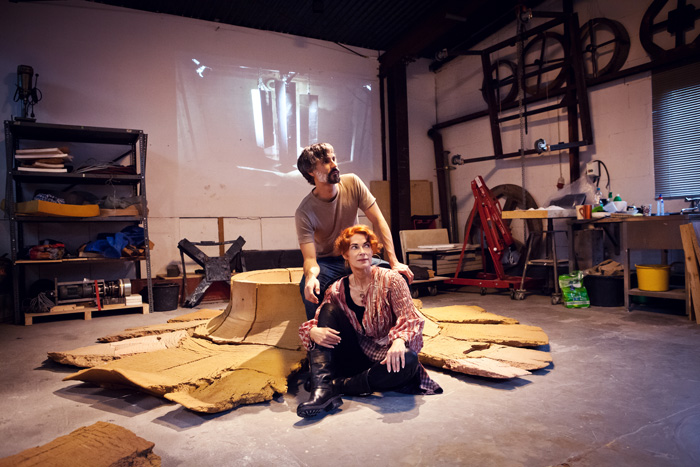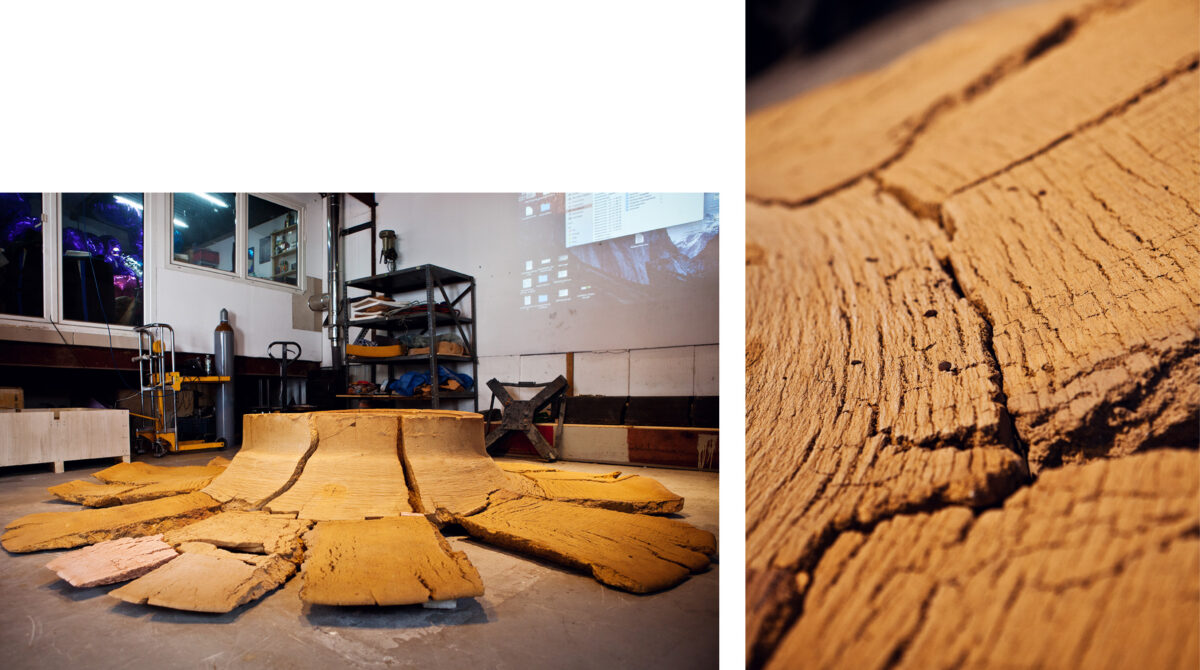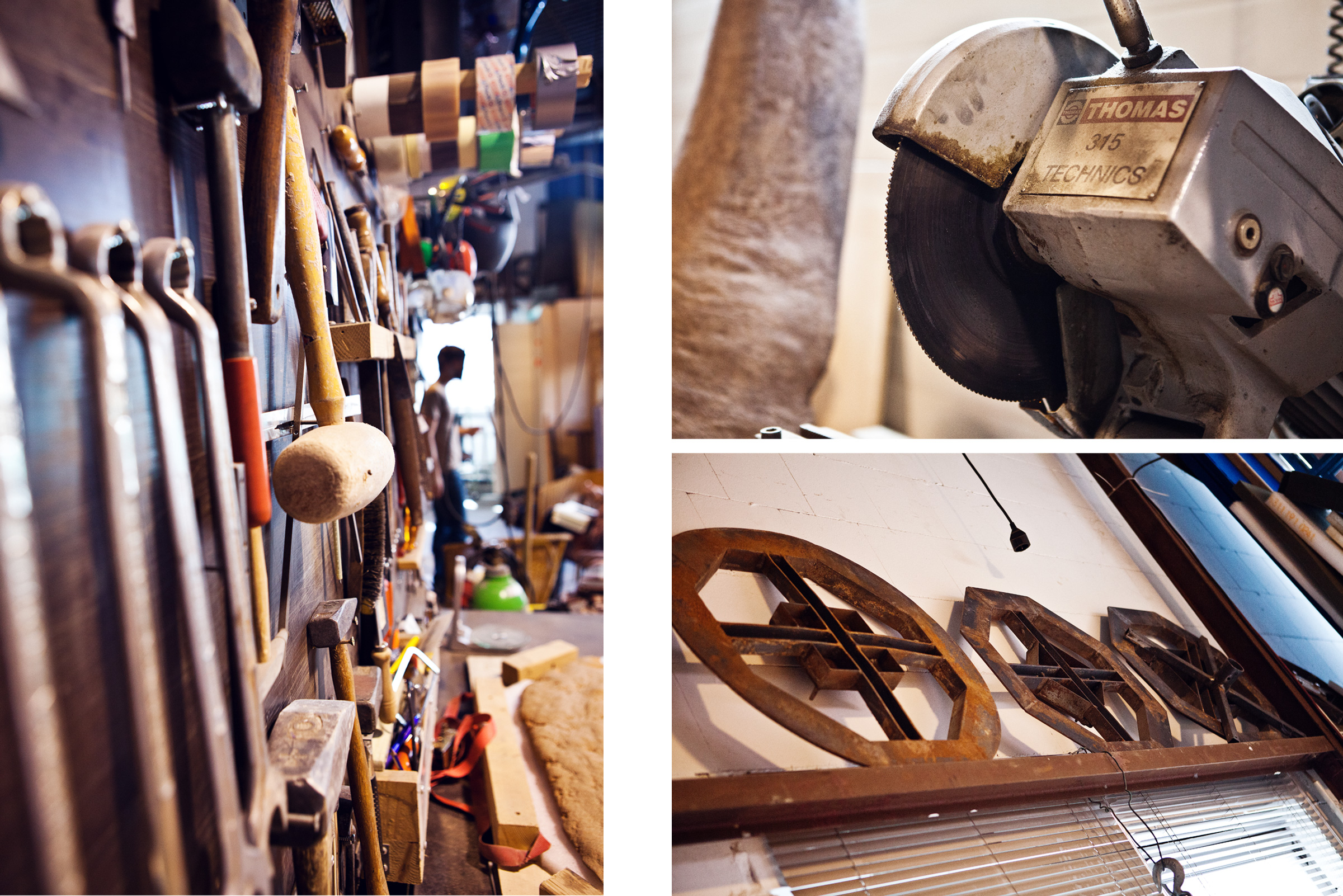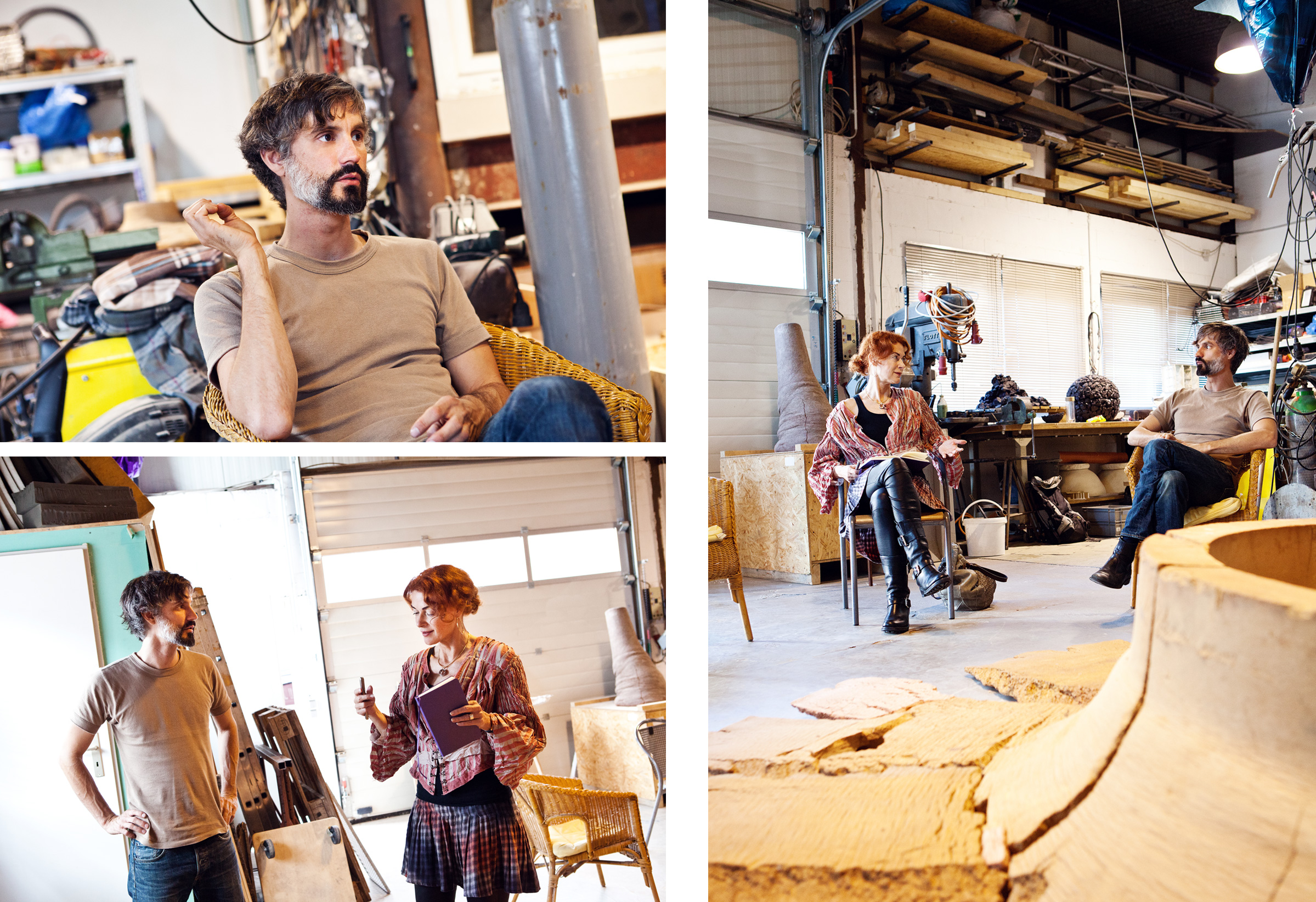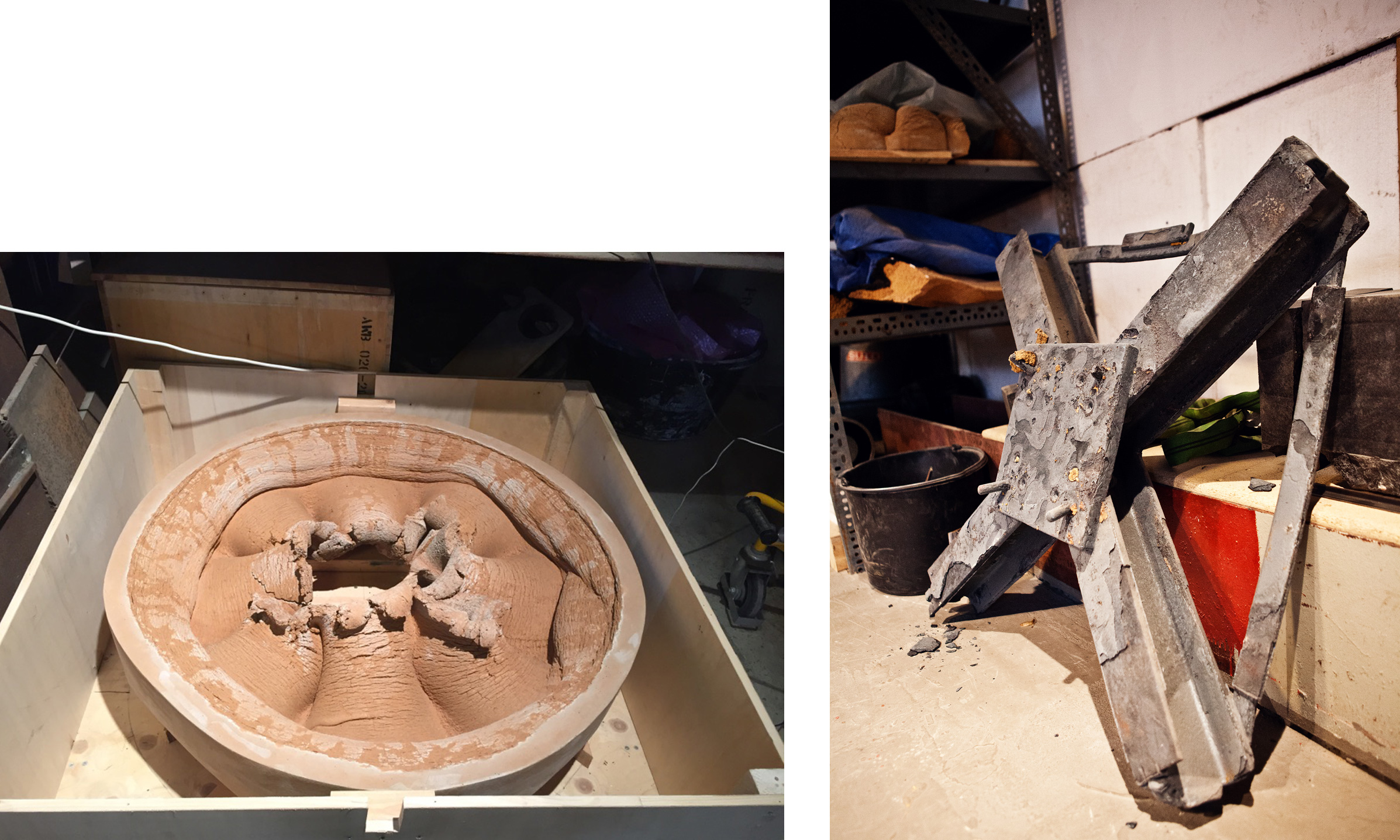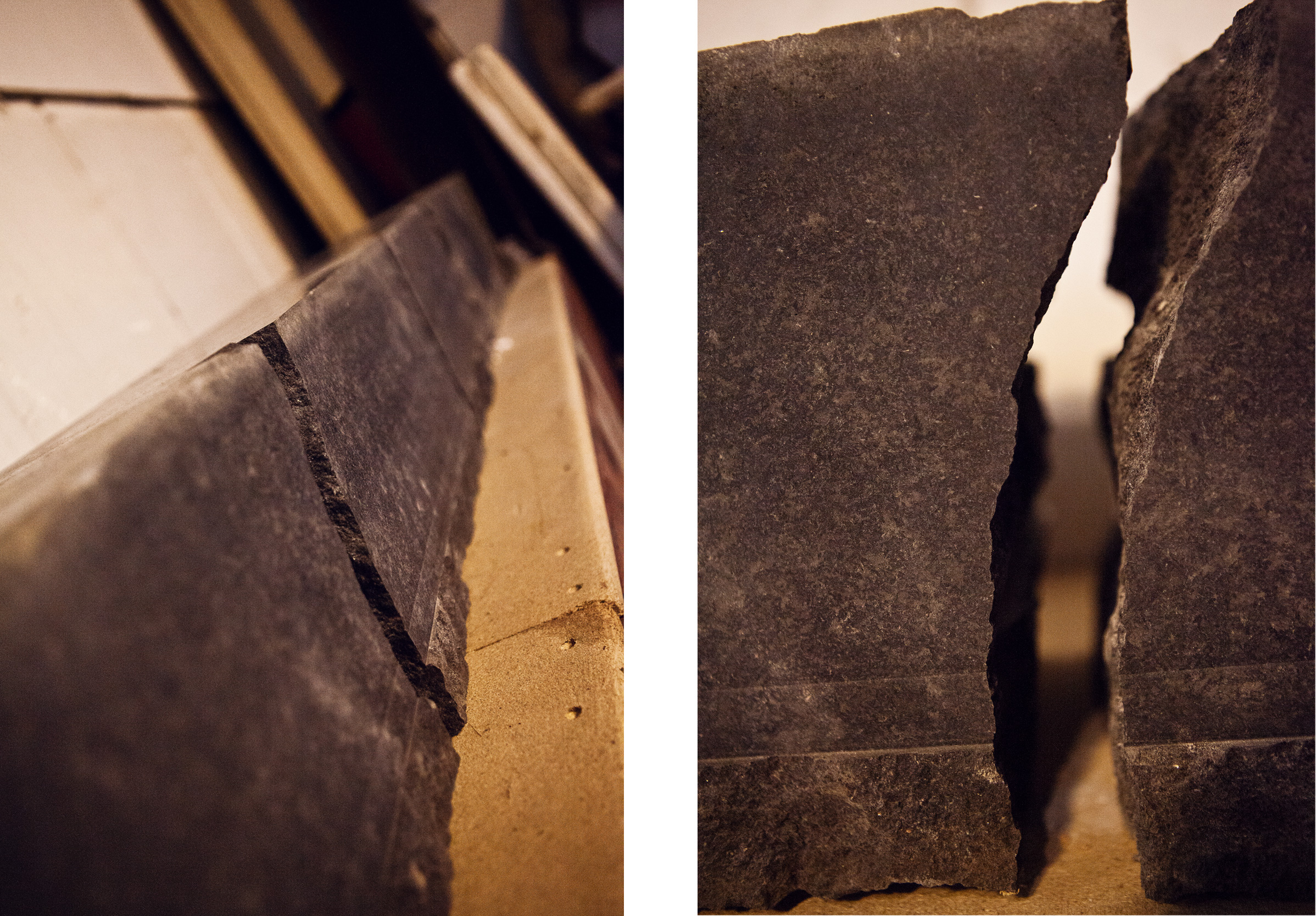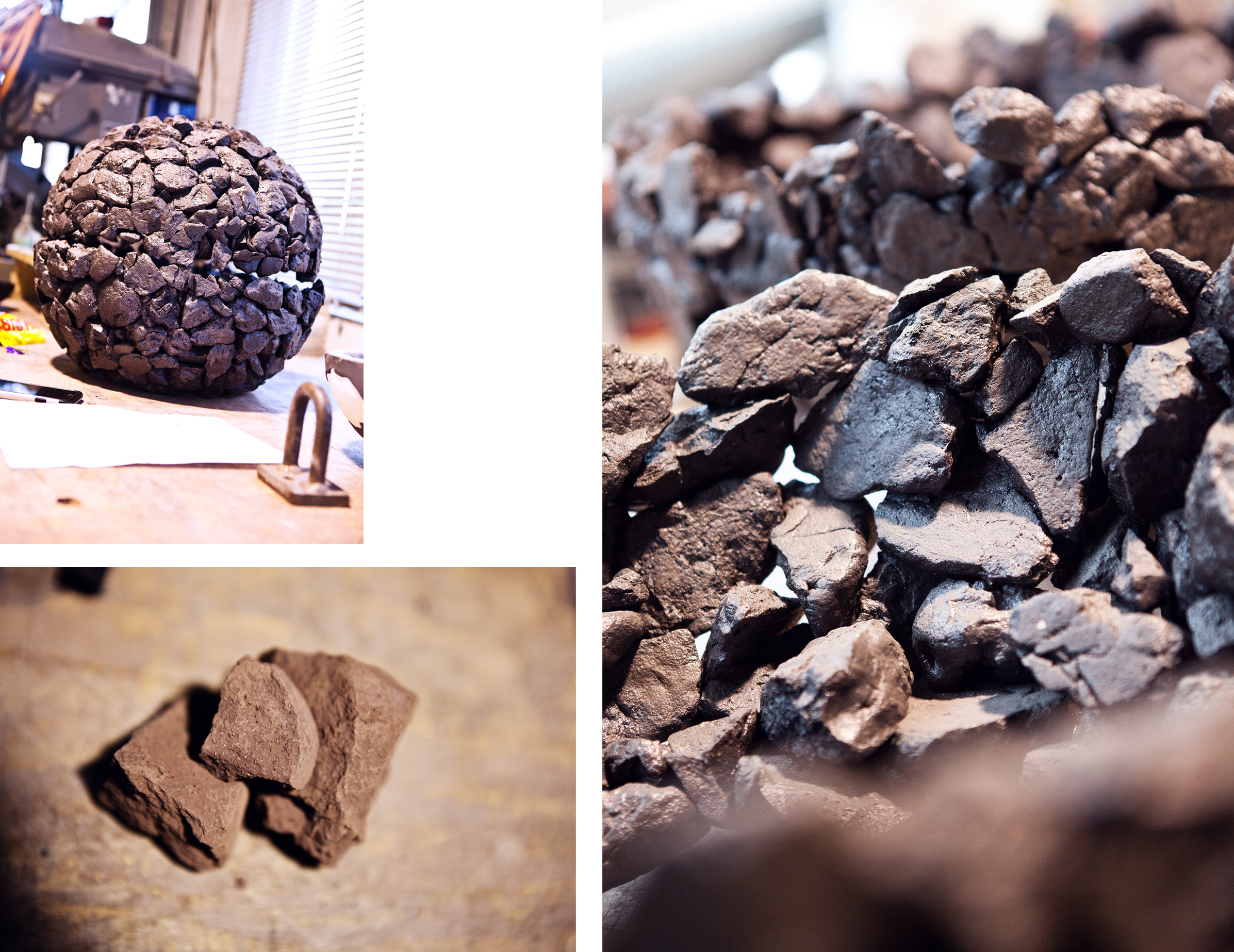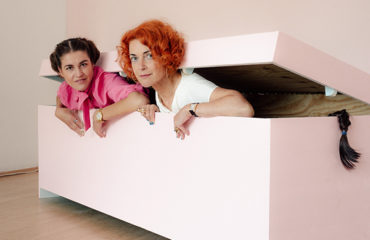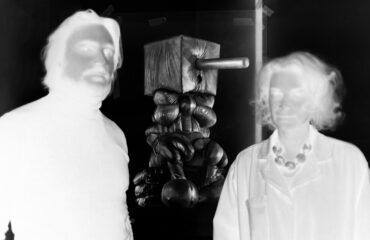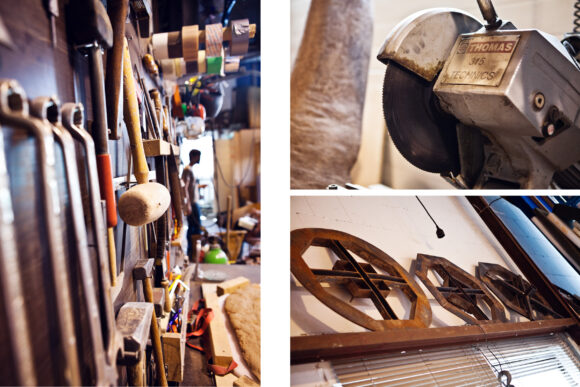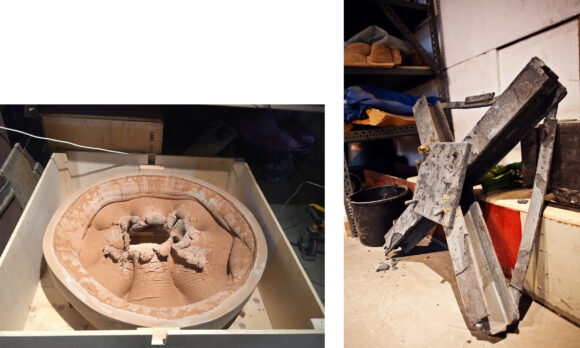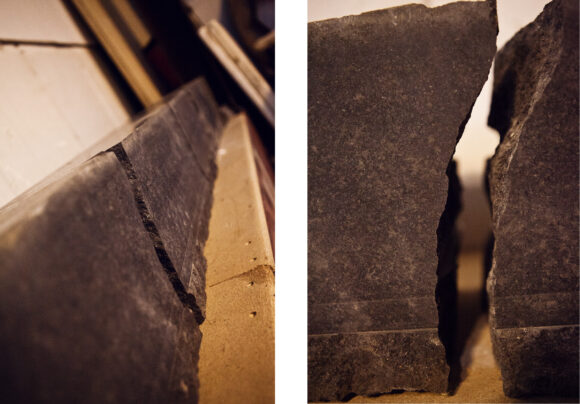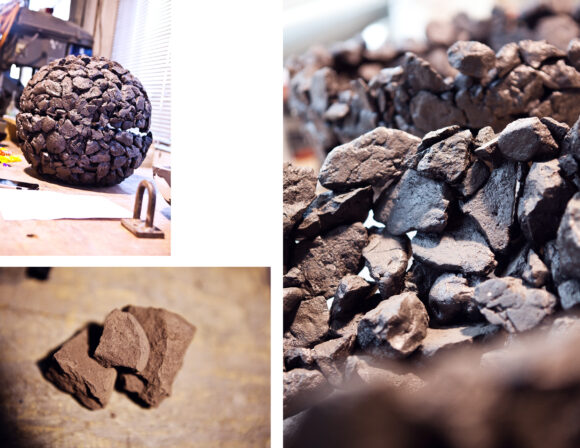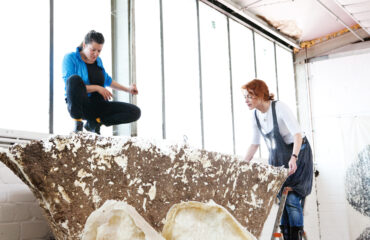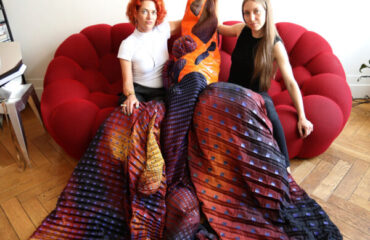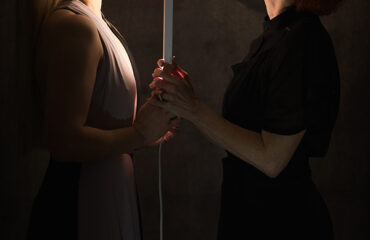Photos: Sarah Schovenberg
Cologne-Mülheim. My present goal leads me to the site of former industrial halls, located directly on the banks of the Rhine. This is where Jan Glisman’s studio is. The artist became particularly well-known through spectacular actions, by means of which he initiated unpredictable processes for his sculptural work. But more about that later…
Due to my early arrival I start to cause confusion at first. While Glisman is darting about from one corner to the other doing the final clean up, I get a relaxed first impression of the studio space. The eyecatcher is a huge sculpture centrally situated which occupies almost half of the total floor area. The colour, structure, and shape are reminiscent of the remains of a tree: in the centre the clean-cut stump, framed by the dried-out wooden surfaces of its trunk which resemble the rotor blades of a helicopter at the centre of the work. However, my touch test clearly shows that it is not wood, but burnt clay. I continue to look around the room.
Furnishings and work tools are a mixture of locksmithery and a ceramics workshop. On a support on the wall lean indefinable steel rims in different sizes. A blown piece of black natural stone piques my curiosity, as do the smaller ones, all of which are organic-looking ceramics, which can be seen on the workbenches. Frontally on the wall, the screen projected by the light of the projector forms the digital counter-pole to the space which besides from that is marked by craftsmanship. “I’ll show you some of my videos in a minute. They will make my work very easy to understand,” Glisman explains the technical composition.
But first we sit down to talk. “Did this huge work in front of us come about because of one of your actions?” I ask to begin. “Yes, exactly. At an art festival, I raised up a two-tonne, still soft stoneware tube with a crane to a height of 25 metres and then let it crash. It resulted in this incredible shape, which I then burnt in an industrial oven,” Glisman explains. “How did you come up with such an idea? Or in other words, what influence did your artistic education have on this work”, I would now like to know.
“After completing my Bachelor’s degree in fine arts, I subsequently did a Master’s degree in scientific illustration. In the transition, the courses from both degrees were running parallel for some time. Infographics had to be drawn as part of scientific illustration. To do this it was necessary to deal with the movement systems of many living beings populating the natural world, among other things. One day I realised very clearly with these naturally occurring systems was also reflected in my artistic attempts. I had dissolved residues of clay clumps in water enriched with cellulose, and then treated the whole mixture in a discarded dough mixing machine to form a sludge mixture. After I removed the water from this mixture, I had developed a rubbery, extremely durable mass. But unfortunately had no idea what I should do with it. Just out for fun, the idea arose of slapping this clay-gum pile on a wooden board and dropping it from the roof window of the fourth floor of the art academy. In doing so, something totally unbelievable happened: the board hit the ground exactly perpendicular, the water remaining in the material shot out and the mixture formed a circle, similar to a water surface into which a stone had been thrown – like an opening that connected two worlds. The feeling that captured me at this sight is hard to describe. I simply felt I had created my first work of art.”
“Since then, I have been fascinated by experiments with materials that are subordinate to such natural processes and which I seem to be able to bring to life in the context of my artistic processes,” Glisman says revealing his key experience with shining eyes. “The core question that has preoccupied me since then is: when and where does existence begin?”
Trailer Trumpets of Jericho
I look at the colossus at our feet again. “But the method of dropping them had to be further developed,” I conclude. “Yes, of course. For this I first constructed these steel wreaths,” he points to the wreaths that I hadn’t been able to categorise before. “In them are the still soft, unburnt stoneware pipes. In order to be able to lift the total load in a controlled manner and let it fall, I then worked out a combined system with an electromagnet. The force of the magnet then sets a counter-pole to the gravity of the earth caused by the magnetic field.”
So the natural system is overloaded, I think. “And the interior modulations of these sculptures are then due to the cross of the steel rim,” I ask incredulously, while I look at the beautiful cross-flowered shapes inside the “stump”. “Yes, exactly. All of the energy was unloaded in the material and developed a life of its own and this new form of existence, despite all controlled preparation,” Glisman says about the sculptural process.
” Something we can’t say about these fragments,” we look at the blasted natural stone blocks together, “what happened here,” I ask. “This is an installation that I developed for a special location. It was based on the architecture of the bunkers 101 in Cologne. For material I used parts of a grave enclosure that had been damaged by air bombs, which had previously been placed to the Cologne cemetery Melaten. I drilled holes in the individual blocks and then mounted it free-floating on a steel construction in the bunker. In the five-week exhibition period, the blocks were then blown up in stages using a source explosive. Here too, natural processes reacted to the work.
For the process as well as for the video recordings it was of crucial importance to know the reaction time from the first crack formation to the final fall of the piece to be blown off. That’s why I did preliminary tests here in my studio. In the bunker, however, I found that the atmospheric effects – i.e., humidity, temperature, etc. – caused completely different reaction times. In order not to miss a rock piece breaking off, I used a video system that was controlled by security software for the film recordings. This program starts the camera recording only when movement begins. The quality of these recordings, however, was inadequate and so I had no choice but to stay in the bunker to control the system manually. It was damn spooky, I tell you,” Glisman reveals. He shows me the video, which in fact had ‘spooky potential’.
Trailer Kon_Takt
In another area of the studio, I notice black-glittering ceramic sculptures. Their colour reminds me of rocks of volcanic origin. Compared to the other works, they seem almost brittle and morbid. Conventional work must have been made here as an exception, I think. Clay shaped, fired, and dark-glazed. But no. I’m totally wrong! “I developed a working method with ceramics, which absolutely is not like the conventional method,” he enlightens me. The individual components of a work are not put together by the processing process, but are fused together by the firing process. “Do you mean that the individual elements of these sculptures are not sculptured, but were created in the oven? Only the basic shape – like for example this ball here – is planned,” I ask. “Exactly. It is based on the recipe or the chemical composition of the material, as well as the programming of the burn curve for the computer which controls the burning process in the oven.”
Ceramic sculptures
Glisman’s inspiration seems to be evolving from the manifold exploration of the materials. But how can his current project be explained? For an exhibition at Vorgebirgspark in Cologne he developed a floating tent. While his previous actions were characterised by moving matter to the earth’s surface, he seems to suspend gravitation here.
Video of the floating tent “Are we right there?”
How does it all fit together, I ask myself finally. I remember the central question of his work. When and where does existence begin? What exactly is concealed behind it? Jan Glisman prefers to work with original, natural materials. With his gravitational work, he demonstrates the natural power of gravity; his performance in the bunker visualised the limits of human protection. But the oldest protective structure of humankind – the tent – he floats …?
It is a mixture of control and powerlessness that is reflected in his work. A mixture that ultimately shapes our existence. At the same time, however, his works symbolise an exciting way of transformation processes – transitions into something undefined, something almost wonderfully new. In the question of where and when existence begins, the answer to when and where it ends or perhaps where it leads is hidden, I think.
Perhaps protected and floating in a new form of existence …?
More information
… about the artist:
www.jan-glisman.com
facebook.com/janglisman.art
instagram.com/jan_glisman
vimeo.com/janglisman
… about the exhibition in Vorgebirgspark Cologne:
